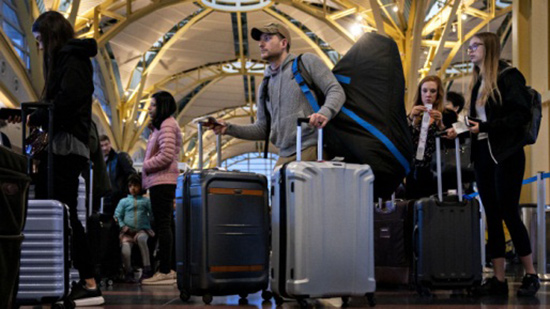技術(shù)能否解決航班延誤問題?

|
放假去哪都不如回家,,當(dāng)然前提是你得能回去,。 美國運輸統(tǒng)計局的數(shù)據(jù)顯示,冬季假期期間航班延誤非常普遍,。2018年12月27日至28日,,美國只有約61%的航班準(zhǔn)點抵離,較正常準(zhǔn)點率低18個百分點,。 這可怪不得登機口的工作人員,。飛機晚點抵達是造成大多數(shù)航班延誤的主要原因,其次就是航空公司的問題,,例如機組,、清潔、維護,、高客流等,,此外還有惡劣天氣的影響,。為了爭奪客運航空業(yè)務(wù),航空公司不斷加推新的航班和低價機票,,也讓航線擁堵問題日益嚴(yán)重,。 航班延誤每年給美國造成近300億美元的損失。乘客誤工損失僅占其中一半,,其余損失主要包括改簽費用,、旅客補償和機組費用。截至2019年12月中旬,,美國人已經(jīng)因為航班延誤而浪費了7500萬分鐘的時間,。 像芝加哥奧黑爾機場、拉瓜迪亞機場和洛杉磯國際機場這些繁忙機場,,如果你覺得它們已經(jīng)飽受航班延誤和航線擁堵的困擾,,那等到2037年你就會知道什么才是真的堵。 國際航空運輸協(xié)會(IATA)表示,,到2037年,,全球航空客運量將從2019年的46億人次增加到每年82億人次。大部分增長將來自亞太和非洲等發(fā)展中市場,,其中北美地區(qū)客運量也將增至14億人次,。 未來,機場將不堪重負(fù),。雖然航空公司增加了航班來提升運力,,但空域和機場基礎(chǔ)設(shè)施的擴容能力有限。國際機場協(xié)會安全,、簡易化和IT事務(wù)主管妮娜·布魯克斯表示,,為了避免即將來臨的混亂局面,并更好地管理機場交通,,航空公司與其合作伙伴正在推動技術(shù)研發(fā)進程,,主要涉及以下三個方面: 第一,外遷機場部分功能,。例如,,遠程托運服務(wù),出發(fā)前從旅客家中,、工作單位或某一指定地點直接取走行李,。然后,通過追蹤服務(wù)確保到達目的地后行李可以順利回到旅客手中,。 第二,,自動化。例如對行李托運,、身份查驗及資料審核等業(yè)務(wù)進行自動化升級,。國際航空運輸協(xié)會簡易化事務(wù)主管席琳·卡努表示,,在不久以后,乘客可以在家中用手機掃描電子護照芯片,,再從不同角度拍幾張自拍,,面部識別系統(tǒng)就能從人群中識別出乘客本人。整個行業(yè)正在推動從護照轉(zhuǎn)向數(shù)字出行證件(DTC)的“簡易化”進程,,并在未來數(shù)年內(nèi)分階段實施,。 美國一些機場試圖引入人臉識別系統(tǒng),但進展并不順利,。即便如此,大家依然認(rèn)為通過在海關(guān)區(qū)域,、甚至是整個機場安裝使用攝像頭能夠減少安全和移民方面的瓶頸,。 第三,數(shù)據(jù)金礦,。 布魯克斯表示:“數(shù)據(jù)是推動行業(yè)變革的動力之源,,它可以幫助我們提升協(xié)作水平,預(yù)測何時會出現(xiàn)客流量高峰,、哪些旅客即將抵達,、運抵的行李有多少等等,有了數(shù)據(jù),,我們可以更靈活的分配資源,,同時也能夠更好地協(xié)調(diào)相關(guān)部門?!? 由于機場各項運營工作分屬多個合作方,,而并非由結(jié)構(gòu)精簡的單一機構(gòu)管理,因此,,很容易產(chǎn)生諸如航班延誤這樣的問題,。而數(shù)據(jù)共享是布魯克斯所謂“全面機場管理方法”的重要一環(huán),在理想情況下,,這一措施能夠有效提升機場運營效率,、減少航班周轉(zhuǎn)時間(飛機從降落到再次起飛的時間),從而增加單位時間內(nèi)飛機起降數(shù)量,。 伊拉·格什科夫是一名航空公司運營系統(tǒng)顧問,,就職于航空市場研究公司T2RL。他表示,,這些技術(shù)創(chuàng)新可能會改善飛行體驗,,但不確定能否提升航空公司的盈利能力。 他說:“航空公司在機場的人工成本已經(jīng)大幅削減,,這里也沒有太多潛力可以挖掘,?!? 目前,航空業(yè)的核心工作還是營收最大化,。一個主要原因是:扣除通貨膨脹影響后,,如今實際票價較1998年時低了59%。盡管需求在增加,,利潤卻依然持續(xù)減少,。為了應(yīng)對這一問題,許多航空公司都在試圖提升客運量,。所以我們看到的是:每天都有更多航班起降,,尤其是在高峰時段新增許多短途區(qū)域航班,票價低廉到足以讓每一個航班都坐滿乘客,。 航空公司的這種策略促使更多人放棄大巴或火車,,從而選乘飛機出行。交通運輸工程師,、芝加哥伊利諾伊大學(xué)教授鄒波(音譯)認(rèn)為,,這會讓機場面臨更嚴(yán)峻的擁堵和延誤風(fēng)險。隨著航班數(shù)量的不斷增加,,如何高效調(diào)度就成了格外復(fù)雜的問題,。 新的航空調(diào)度、干擾管理和飛機定位監(jiān)控技術(shù)可以幫助疏解機場的部分壓力,,容納更多航班,,這對維持機場的正常運轉(zhuǎn)至關(guān)重要。例如,,美國正在開發(fā)新一代空中交通管制系統(tǒng)ADS-B,,該項目目前處于收尾階段,將使用基于GPS的衛(wèi)星跟蹤系統(tǒng)取代傳統(tǒng)的地面雷達系統(tǒng),。新系統(tǒng)啟用后將能有效縮短飛機之間的飛行間距,,從而增加空域容量。 旅行技術(shù)公司Amadeus負(fù)責(zé)航空公司戰(zhàn)略咨詢的副總裁吉姆·巴洛表示,,飛行排班與客流管控軟件也可以幫助航空公司提升效率,,從而節(jié)省大筆資金。他在一封電子郵件中寫道:“通過使用專門軟件優(yōu)化排班,,航空公司可以增加相當(dāng)于其年營收1%至3%的收入,,如果全行業(yè)推行,則能為其帶來數(shù)十億美元的產(chǎn)值,?!? 盡管有了這些創(chuàng)新,但由于單一航班出錯或延誤導(dǎo)致后續(xù)航班大面積延誤的案例仍然屢見不鮮。鄒波說:“某一航班出現(xiàn)延誤可能會導(dǎo)致其他航班也無法按時抵離,,有點像乘數(shù)效應(yīng),。” 邁克爾·拜亞達是一名資深飛行員,,現(xiàn)任航空管理解決方案公司ATH集團的總裁,。他表示,目前延誤傳播管理仍然停留在局部層面,,無法形成更廣泛的漣漪效應(yīng),。缺乏系統(tǒng)性解決方案也會造成“噴氣動力式堵塞”。 “就像下課鈴響后,,上百個孩子同時沖向門口一樣,。” 技術(shù)可以幫助航空業(yè)部分解決航班延誤和其他一些問題,,但要想滿足未來的需求,,除了對效率低下的現(xiàn)有系統(tǒng)做些修修補補,還需要進行更實質(zhì)性的改變,。未來或許需要興建更多的機場基礎(chǔ)設(shè)施以應(yīng)對不斷增加的客流量,例如跑道,、候機大廳,、航站樓,甚至是機場,。 但是,,正如我們在高速公路上看到的那樣,增加車道并不會減少車流量,,實際上往往會吸引更多車輛上路,。對于客運航空而言,日益繁忙的機場和天空可能也意味著會出現(xiàn)更多航班延誤,。格什科夫說:“越來越多的機場會進入高負(fù)荷運轉(zhuǎn)的狀態(tài),,全球機場運力將瀕于飽和?!? 不管怎么看,,航空業(yè)所面臨的困境都是自食其果。作為一個以變革緩慢而著稱的行業(yè),,它那些雄心勃勃的想法到2037年都未必能得到廣泛推行,。 因此,如果在未來17年內(nèi)的某個時間您打算乘飛機出行,,請系好安全帶:航班延誤情況短期內(nèi)難見好轉(zhuǎn),,可能只會更糟。(財富中文網(wǎng)) 丹·卡其波爾對本文亦有貢獻。 譯者:梁宇 審校:夏林 |
There’s no place like home for the holidays—if you can get there. Airport delays are so common during the winter holiday season that on Dec. 27 and 28 of last year, American travelers had only about a 61% chance of departing or arriving on time, according to the Bureau of Transportation Statistics. That’s 18 percentage points lower than 2018’s normal on-time performance. Don’t blame the gate agents. Year-round, most delays are caused by aircraft arriving late, followed by carrier problems like staffing, cleaning, maintenance, heavy traffic volume, and bad weather. Congestion, in particular, is a growing problem as airlines jockey for passengers’ business with more departures and rock-bottom airfares. Together, these delays cost the United States nearly $30 billion a year. The cost of passengers’ lost time constitutes half that figure, with rebooking fees, passenger compensation, and staffing making up the bulk of the remainder. So far in 2019, delays have eaten up 75 million minutes of U.S. passengers’ time. But if you think busy airports like Chicago O’Hare, LaGuardia, and LAX are troubled with delays and congestion now, just wait until 2037. That’s when the International Air Travel Association (IATA) says global passenger air travel will reach 8.2 billion passengers a year, up from 2019’s estimated 4.6 billion—“passengers” is defined by total origin-destination journeys, not unique individuals. While the majority of gains will be in developing markets like Asia-Pacific and Africa, 1.4 billion of those future passengers will be traveling in North America. The airport crunch is coming. Even as airlines add flights to accommodate the increase in passengers, airspace and infrastructure can be stretched only so far. To head off the impending chaos, airlines and partners are pursuing three main technology themes aimed at managing airport traffic, said Nina Brooks, director of security, facilitation, and IT at Airport Council International (ACI). The first is moving things away from the airport, such as remote baggage collection. For instance, a luggage collection service would pick up bags from people at home, work, or at a downtown location prior to travel. Then, tracking services would work to ensure travelers are reunited with their bags at their final destination. The second is automation, as in automated bag drop, ID verification, and document checking. IATA’s head of facilitation Céline Canu said that not too far off in the future, some passengers will be able to scan their e-passport chips at home using their smartphones, then take a few selfies from several angles—enough to train a biometric facial recognition system to pick passengers out of a crowd. This is part of an industry-wide movement away from passports and toward digital travel credentials (DTC, or “facilitation” in industry parlance), which will be introduced in stages over the next several years, said Canu. Some attempts to introduce facial recognition at U.S. airports have not gone very smoothly so far. Even so, the thinking is that it will reduce bottlenecks at security and immigration by using cameras in the customs area and perhaps even around the airport. The third, data, is the industry’s golden ticket. “That really is the game-changer, allowing us to become more coordinated and to be able to predict when the peaks are going to come, who’s coming, what volume of baggage is coming, to be able to be more flexible with resources and better coordinated between all the different parties,” Brooks said. Because various components of airport operations are managed by multiple partners and not one single, streamlined entity, a lot can fall through the cracks and cause problems such as delays. Sharing data is integral to what Brooks called a “total airport management approach,” which, in an ideal scenario, would make operations so efficient that airports could reduce turnaround times (the time between when a flight lands and takes off again) and process more aircraft. Ira Gershkoff, a consultant on airlines’ operations systems at airline market research firm T2RL, said these innovations may improve the experience of flying, but he isn’t so sure these technologies will improve profitability. “Airlines have already cut a good chunk of their airport labor cost, and there’s not that much more productivity to be gained there,” he said. Right now, the airline industry is focused on revenue maximization. A major reason for that is because airplane tickets cost 59% less today than in 1998, after inflation. That has resulted in dwindling profits, even as demand grows. To make up for the shortfalls, many carriers look for ways to drive up passenger volume. This can look like more flights per day, especially increasing short-haul regional flights during peak times, with fares cheap enough to fill the airplanes up as much as possible. This airline strategy encourages more people to travel by plane instead of by bus or train. Bo Zou, a transportation engineer and professor at the University of Illinois at Chicago who studies delay propagation in air travel, said that approach can expose airports to greater congestion and delay challenges. With more and more time-sensitive moving parts, orchestrating a high level of efficiency becomes incredibly complicated. New approaches to airplane scheduling, disruption management, and aircraft positioning surveillance can help alleviate some of the strain and accommodate new traffic, which are imperatives for staying in business. The U.S.-based NextGen program, for instance, is in the last stage of switching air traffic control from legacy ground-based radar systems to GPS-based satellite tracking. The new system, known as ADS-B, will help aircraft fly closer to one another, which would increase airspace capacity. Jim Barlow, vice president of airline strategic consulting at travel technology company Amadeus, said scheduling and passenger-flow software can also help airlines recoup big money by buttoning up inefficiencies. “Those that are successfully optimizing their schedules in this way can capture around 1%–3% of their annual revenue, which represents billions of dollars across the industry as a whole,” he said in an email. Despite these innovations, it’s still not uncommon for one mistake or late arrival in the morning to cause cascading delays across a whole day’s operations. “The delay of one aircraft can propagate—spread out—to more flights, so that’s kind of a multiplier effect,” said Zou. Michael Baiada, a longtime airline pilot and now president of airline management solutions company ATH Group, said managing delay propagation currently happens at too local a level to manage wider ripple effects. The lack of a system-wide solution can create a jet-powered traffic jam. "It’s like ringing the bell for the end of recess: A hundred kids rush for the door," Technology can help solve some elements of delays and other aviation problems, but it’ll take more than layering bells and whistles on top of an inefficient existing system to make the kind of meaningful change required to meet future demand. At some point more airport infrastructure—new runways, concourses, terminals, and even airports—will need to be built to accommodate future passengers. However, as we’ve seen on highways, adding lanes does not equal less traffic; it actually means even more cars. For passenger air travel, busier airports and skies could mean even more delays. “More and more airports will be slot-constrained, and this will mean that there will be little slack in airport capacity around the world,” said Gershkoff. In many ways, the airline industry is the maker of its own misery. The industry is notoriously slow to change, so widespread implementation of all its great ideas may not even be complete by 2037. So, if you’re planning on flying sometime in the next 17 years, buckle up: Delays may get worse before they get better. Dan Catchpole contributed reporting to this article. |













